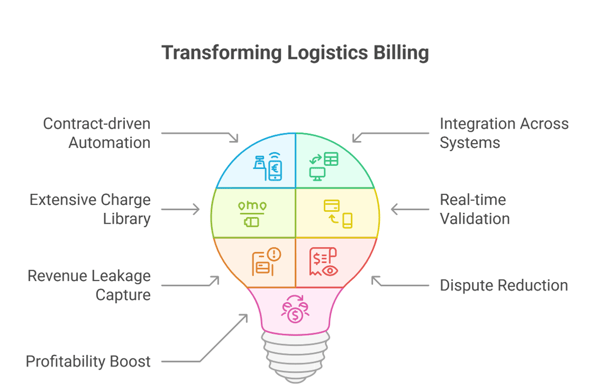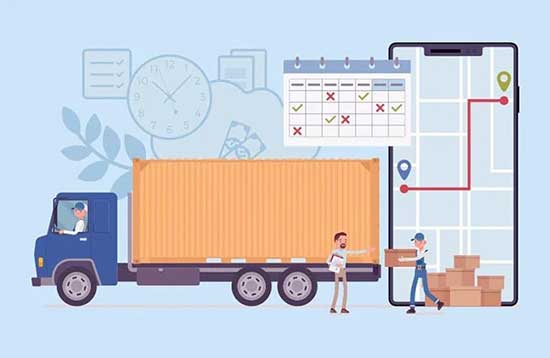
The Role of Dynamic Billing in 3PL Australia for Improving Profitability
The Role of Dynamic Billing in 3PL Australia for Improving Profitability
9:18
Published :

Dynamic billing in 3PL Australia is gaining attention as the logistics industry feels the squeeze from rising fuel prices, labor shortages, and stricter compliance rules, even as freight volumes continue to grow.
Global shipping-cost shocks have pushed up freight service inflation in Australia. A 10-point rise in global shipping cost inflation often shows up as a 0.4 to 0.75 percentage point increase in shippable goods inflation over one to two years.
Yet, despite the demand, third-party logistics providers (3PLs) are struggling to maintain healthy margins. Most investments in logistics systems focus on TMS software or warehouse management systems, yet billing is rarely treated as a core part of the integration. For 3PLs in Australia, this is where gaps begin to show—highlighting the importance of dynamic billing in 3PL Australia to address complex contracts, multi-leg shipments, and delayed invoicing that silently erode profits.
Behind the scenes, the way 3PLs bill for their services often determines the difference between profit and leakage. Let’s dive into the various problems associated with billing in the 3PL sector, where inefficiencies can significantly impact profitability.
Billing may look like a routine back-office process, but in logistics, it plays a central role in keeping margins intact. For 3PLs in Australia, the challenge is not just moving goods efficiently but also ensuring dynamic billing in 3PL Australia accurately captures every leg, service, and contractual clause. Below are the four most common problem areas..
These challenges show why dynamic billing in 3PL Australia isn’t just an administrative function; it’s a critical piece of 3PL profitability, and when it fails, the impact runs deeper than most realize.
When billing breaks down the effect is felt across the entire 3PL business. In dynamic billing in 3PL Australia failures are not just about missed revenue they also cost valuable time erode trust and drain operational capacity. The most common impacts are clear:
These consequences show that billing errors don’t stay in the back office they spill over into profitability relationships and competitiveness. To break this cycle 3PLs in Australia need a smarter approach with dynamic billing in 3PL Australia that is automated and integrated within advanced logistics systems.
The problems with billing do not come from a lack of effort; they come from outdated processes. Relying on manual checks, spreadsheets, and scattered systems leaves too many cracks for revenue to slip through. Dynamic billing in 3PL Australia offers a smarter alternative, built around automation, integration, and accuracy.
Ramco’s logistics software, with its advanced TMS software and WMS software, embeds these capabilities directly for seamless contract-based billing in Australian 3PLs.

Dynamic billing isn’t just an upgrade to invoicing. It’s a shift in how 3PLs align their operations with financial outcomes, ensuring every service delivered translates into revenue earned. By utilizing integrated logistics systems, 3PLs can transform billing from a pain point into a strategic advantage.
Billing is often the missing link in 3PL profitability. While operations teams focus on moving goods faster and cheaper, gaps in invoicing quietly erode margins and trust. Manual processes are no longer enough in an industry defined by complexity, penalties, and tight cash cycles.
The way forward is clear: automated dynamic billing in 3PL Australia that turns every service into accurate revenue. With Ramco’s third-party logistics system, built on an integrated transportation management system and warehouse management software, Australian 3PLs can embed billing into their logistics operations, achieving accuracy, transparency, and audit-ready invoicing. As part of a modern Logistics ERP, this makes billing not just a back-office task, but a lever for profitability.
Enterprise asset management (EAM) involves the management of mission critical assets of an organization throughout each asset's lifecycle. EAM is used to plan, optimize, execute, and track the needed maintenance activities with the associated priorities, skills, materials, tools, and information. The aim is to optimize the quality and utilization of assets throughout their lifecycle, increase productive uptime and reduce operational costs.
Enterprise asset management (EAM) involves the management of the maintenance of physical assets of an organization throughout each asset's lifecycle. EAM is used to plan, optimize, execute, and track the needed maintenance activities with the associated priorities, skills, materials, tools, and information.
The software helps in effective maintenance of assets through preventive, predictive, shutdown and breakdown maintenance strategies. The system also helps enterprises mitigate equipment risks by enhanced safety standards. The streamlined operations and improved asset performance helps organizations increase their investment effectiveness.
EAM is important because it helps organizations track, assess, manage and optimize asset quality and reliability. Asset intensive Organizations have hundreds, thousands, even millions of assets which needs to be maintained to maximize / optimize life of these assets to increase the return on investment.
The key features of effective EAM are:
Asset Intensive companies under the following Industries :
Contact us for a meeting and schedule a demo
This differs on case to case basis, based on the type of installation and unique industry specific requirements. Contact us for a meeting and schedule a demo.
This differs on case to case basis, based on the type of installation and unique industry specific requirements. Contact us for a meeting and schedule a demo.
Stay Connected, follow us on LinkedIn / Twitter to know more about EAM Software latest trends.

All Rights Reserved. © Copyright 2024. Ramco Systems.